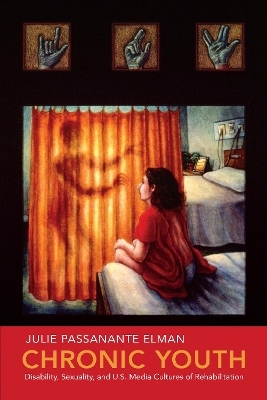
Chronic Youth
Disability, Sexuality, and U.S. Media Cultures of Rehabilitation
Seiten
2014
New York University Press (Verlag)
978-1-4798-4142-4 (ISBN)
New York University Press (Verlag)
978-1-4798-4142-4 (ISBN)
Spotlighting the "troubled teen" as a site of pop cultural, medical, and governmental intervention, this book traces the teenager as a figure through which broad threats to the normative order have been negotiated and contained. It shows how teenagers became a lynchpin for a culture of perpetual rehabilitation and neoliberal governmentality.
The teenager has often appeared in culture as an anxious figure, the repository for American dreams and worst nightmares, at once on the brink of success and imminent failure. Spotlighting the “troubled teen” as a site of pop cultural, medical, and governmental intervention, Chronic Youth traces the teenager as a figure through which broad threats to the normative order have been negotiated and contained.
Examining television, popular novels, science journalism, new media, and public policy, Julie Passanante Elman shows how the teenager became a cultural touchstone for shifting notions of able-bodiedness, heteronormativity, and neoliberalism in the late twentieth century. By the late 1970s, media industries as well as policymakers began developing new problem-driven ‘edutainment’ prominently featuring narratives of disability—from the immunocompromised The Boy in the Plastic Bubble to ABC’s After School Specials and teen sick-lit. Although this conjoining of disability and adolescence began as a storytelling convention, disability became much more than a metaphor as the process of medicalizing adolescence intensified by the 1990s, with parenting books containing neuro-scientific warnings about the incomplete and volatile “teen brain.” Undertaking a cultural history of youth that combines disability, queer, feminist, and comparative media studies, Elman offers a provocative new account of how American cultural producers, policymakers, and medical professionals have mobilized discourses of disability to cast adolescence as a treatable “condition.” By tracing the teen’s uneven passage from postwar rebel to 21st century patient, Chronic Youth shows how teenagers became a lynchpin for a culture of perpetual rehabilitation and neoliberal governmentality.
The teenager has often appeared in culture as an anxious figure, the repository for American dreams and worst nightmares, at once on the brink of success and imminent failure. Spotlighting the “troubled teen” as a site of pop cultural, medical, and governmental intervention, Chronic Youth traces the teenager as a figure through which broad threats to the normative order have been negotiated and contained.
Examining television, popular novels, science journalism, new media, and public policy, Julie Passanante Elman shows how the teenager became a cultural touchstone for shifting notions of able-bodiedness, heteronormativity, and neoliberalism in the late twentieth century. By the late 1970s, media industries as well as policymakers began developing new problem-driven ‘edutainment’ prominently featuring narratives of disability—from the immunocompromised The Boy in the Plastic Bubble to ABC’s After School Specials and teen sick-lit. Although this conjoining of disability and adolescence began as a storytelling convention, disability became much more than a metaphor as the process of medicalizing adolescence intensified by the 1990s, with parenting books containing neuro-scientific warnings about the incomplete and volatile “teen brain.” Undertaking a cultural history of youth that combines disability, queer, feminist, and comparative media studies, Elman offers a provocative new account of how American cultural producers, policymakers, and medical professionals have mobilized discourses of disability to cast adolescence as a treatable “condition.” By tracing the teen’s uneven passage from postwar rebel to 21st century patient, Chronic Youth shows how teenagers became a lynchpin for a culture of perpetual rehabilitation and neoliberal governmentality.
Julie Elman is Assistant Professor of Women's & Gender Studies at the University of Missouri.
Contents Acknowledgments ix Introduction: From Rebel to Patient 1 1 Medicine Is Magical and Magical Is Art: Liberation and Overcoming in The Boy in the Plastic Bubble 29 2 After School Special Education: Sex, Tolerance, and Rehabilitative Television 63 3 Cryin' and Dyin' in the Age of Aliteracy: Romancing Teen Sick-Lit 93 4 Crazy by Design: Neuroparenting and Crisis in the Decade of the Brain 131 Conclusion: Susceptible Citizens in the Age of Wiihabilitation 167 Notes 177 Bibliography 205 Index 231 About the Author 243
| Reihe/Serie | NYU Series in Social and Cultural Analysis |
|---|---|
| Zusatzinfo | 2 black and white illustrations |
| Verlagsort | New York |
| Sprache | englisch |
| Maße | 152 x 229 mm |
| Gewicht | 517 g |
| Themenwelt | Sachbuch/Ratgeber ► Gesundheit / Leben / Psychologie ► Familie / Erziehung |
| Recht / Steuern ► EU / Internationales Recht | |
| Sozialwissenschaften ► Kommunikation / Medien ► Medienwissenschaft | |
| Sozialwissenschaften ► Soziologie ► Gender Studies | |
| ISBN-10 | 1-4798-4142-0 / 1479841420 |
| ISBN-13 | 978-1-4798-4142-4 / 9781479841424 |
| Zustand | Neuware |
| Haben Sie eine Frage zum Produkt? |
Mehr entdecken
aus dem Bereich
aus dem Bereich
erfolgreiche Strategien für Erwachsene und Kinder
Buch | Softcover (2023)
Klett-Cotta (Verlag)
CHF 38,90
das Handbuch für die individuelle Impfentscheidung
Buch | Softcover (2023)
Knaur MensSana (Verlag)
CHF 31,90
Born to be wild: Wie die Evolution unsere Kinder prägt. Mit einem …
Buch | Hardcover (2022)
Kösel (Verlag)
CHF 33,90


